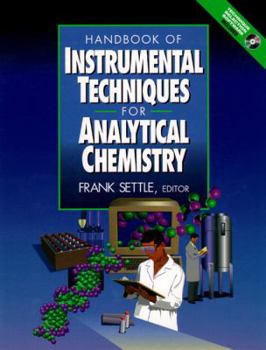Handbook of Instrumental Techniques for Analytical Chemistry
This handbook covers the most important instrumental techniques in analytical chemistry, including separation techniques, qualitative and quantitative optical spectroscopic techniques, mass... This description may be from another edition of this product.
Format:Hardcover
Language:English
ISBN:0131773380
ISBN13:9780131773387
Release Date:June 1997
Publisher:Prentice Hall
Length:995 Pages
Weight:5.65 lbs.
Dimensions:10.3" x 1.8" x 8.3"
Customer Reviews
2 ratings
A Good book for Any instrumental Lab
Published by Thriftbooks.com User , 24 years ago
This book is a must for the instrumental chemist. It covers it some detail most general and specialized instrumental techniques employed by chemist. It also gives specific applications of these techniques, manufacturers of instruments and supplies, and estimates on costs. In my lab I often find people first refering to this book when reviewing a new technique or wishing to 'brush up' on a technique they have not used in a while. It is a good first reference and I reccomend it to any analytical chemist.
Review from Analytical Consumer
Published by Thriftbooks.com User , 28 years ago
Have you ever tried to explain what analytical chemistry is, to a friend, relative, or stranger feigning interest in what you do? The attempt quickly reveals the depth and complexity of a field so easily named with two simple words. Where do you begin? What do you leave out? Trying to write a textbook on the many facets of analytical chemistry is even more difficult; some attempts run to many volumes. Some texts focus on the physical principles of a technique, others on the applications. Prentice-Hall's new Handbook of Instrumental Techniques for Analytical Chemistry (Frank Every lab occasionally faces a problem outside the usual routine - questions their normal instruments can't answer. The Handbook helps them figure out what instruments might do the job. The goal of the book is to introduce nonspecialist scientists to the major techniques, outlining how each works, what it does, its limitations, the information produced, plus practical matters such as costs to buy and operate, and the expertise required of an operator. Each chapter has a list of manufacturers and a bibliography for further self-education. A person who goes through a chapter will be ready to ask intelligent questions of experts in the field and understand the buzzwords peculiar to each discipline. The book contains a CD-ROM with software for selecting appropriate methods for a sample and analysis; since it runs on Windows (3.1, 95, or NT), I couldn't test it on my Macintosh. The authors of the chapters are a mix of university researchers, innovators from industry, and a few carefully-selected experts from instrument companies, who avoid the temptation to promote their own products. For example, the STM/AFM chapter was written by Huub Salemink of the IBM labs in Zurich, where the technique was pioneered. Although I don't want to slight any of the excellent authors who contributed chapters, some areas are truly outstanding texts in their own right. Ron Majors' discussion of organic sample preparation is as thorough as readers of his LC*GC columns would expect. Robert Megargle covers LIMS with the knowledge of many years as user and observer. Defining categories for the overlapping techniques of analytical chemistry is always a challenge. Settle wisely avoided the traditional choice of categorization by underlying physical principles and grouped them according to logical applications. The result includes some based on the instrument types (separation methods, for example) and others on broad application areas (polymer analysis). While purists might fret over this organization, in fact, it makes for easy access, without having to shuffle through the whole book to gather information on a specific analysis. In a single volume covering fields that are often evolving rapidly, there are bound to be a few omissions. The ones I noted were: near infrared (NIR) spectroscopy, which has become so important recently; microscopy other than SPM, especially the analytical use of electron





